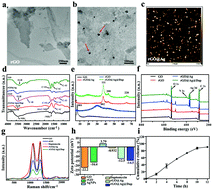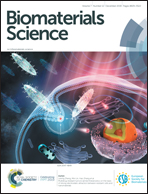Daptomycin and AgNP co-loaded rGO nanocomposites for specific treatment of Gram-positive bacterial infection in vitro and in vivo†
Abstract
In order to improve the stability of AgNPs and decrease the dosage of Daptomycin for killing bacteria, a reduced graphene oxide (rGO) was used for simultaneously anchoring AgNPs and Daptomycin to prepare rGO@Ag@Dap nanocomposites. In vitro experiments showed that the nanocomposites can efficiently kill four kinds of pathogenic bacteria, especially two kinds of Gram-positive bacteria (Staphylococcus aureus and Bacillus subtilis) through damaging cell integrity, producing ROS, decreasing ATP and GSH and disrupting bacterial metabolism. Against Gram-positive bacteria, the rGO@Ag@Dap nanocomposites showed a cooperative antibacterial effect. Moreover, in vivo experiments showed that rGO@Ag@Dap can improve the healing of wounds infected with bacteria by efficiently killing the bacteria on the wounds and further promoting skin regeneration and dense collagen deposition. In summary, the above results suggest that the cooperative function of AgNPs with Daptomycin can significantly improve antibacterial efficiency against infectious diseases caused by bacteria, especially for therapies made ineffective due to the drug resistance of pathogenic bacteria.



 Please wait while we load your content...
Please wait while we load your content...